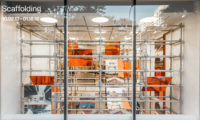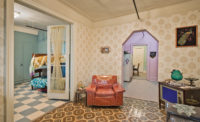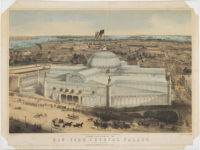Ai Weiwei is known for pushing boundaries. The artist and activist—who has a long history of dissent, particularly with regard to China’s communist regime—famously had his passport revoked by Chinese authorities in 2011, ostensibly for tax evasion. Since gaining back his right to travel abroad in 2015, Ai has made a triumphant return to New York City—where he lived and practiced in the 1980s—with numerous gallery shows, an interactive exhibit designed with Herzog & de Meuron, and, now, a citywide display of installations titled Good Fences Make Good Neighbors. With this new work, Ai explores boundaries rather than tests them, riffing off the security fence to call attention to the international migration crisis and examine the notion of belonging.
Sponsored by the Public Art Fund, Good Fences Make Good Neighbors comprises 18 site-specific works across Manhattan, Brooklyn, the Bronx, and Queens. Although the installations take on varying sizes and shapes, and incorporate different materials, each alludes to a type of physical barrier. For instance, the display surrounding the Unisphere in Queens’ Flushing Meadows Corona Park is a low perimeter, bench-like structure composed of mesh netting strung around metal stanchion barriers. In Washington Square Park, Ai placed a polished mirror passageway encased in a nearly 40-foot-tall metal cage under the Stanford White-designed triumphal arch; at the southeast entrance to Central Park, he put a large golden cage that passersby can enter. Artworks also include metal trellises fastened to the rear end of bus shelters in Downtown Brooklyn, Harlem, and the Bronx.
While certain displays encourage pedestrians to engage with them, transforming physical symbols of division into places for exploration, respite, and even selfies, other installations, such as a fence spanning the gap between two buildings on the Lower East Side—a historic enclave for immigrants and displaced persons—are meant to be pondered from afar; their subtelty can be viewed as a statement on the normalization of these divisive structures. Over 300 citywide “interventions,” which include lamppost banners depicting historical and contemporary portraits of immigrants, and bus shelter posters with images from Ai’s travels to refugee camps—the focus of his new film Human Flow—are also part of the exhibition.
It seems fitting that Good Fences Make Good Neighbors debuts just as prototypes for the U.S.-Mexico border wall are being built in San Diego, but in a public conversation last week at the Cooper Union—a site for one of Ai’s installations—Ai insisted to chief curator of the Public Art Fund Nicholas Baume that they “not talk about politics.” Although the exhibition is inspired by the current geopolitical situation, there is no singular political message to glean (when asked by an audience member what he hoped people would take away from the exhibit, Ai responded, “I hope they forget about it.”) Rather, for Ai, Good Fences offers the public opportunities to experience the city in unexpected ways, if only for a moment. “I tried to make a work that makes people feel differently,” Ai said to Baume. “To feel a difference—it is very important. We’re so used to our daily lives, and that difference means a lot to people.”
Good Fences Make Good Neighbors will be on view through February 11, 2018.



























Post a comment to this article
Report Abusive Comment